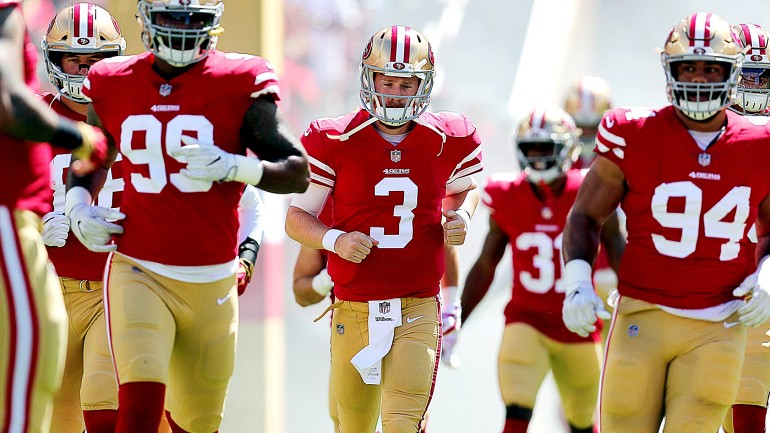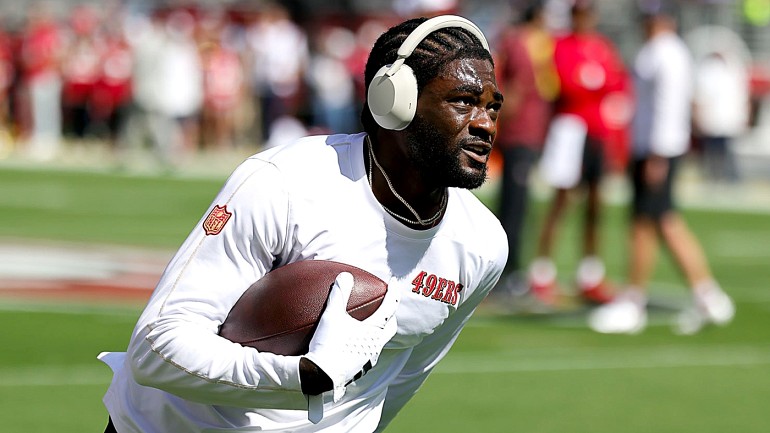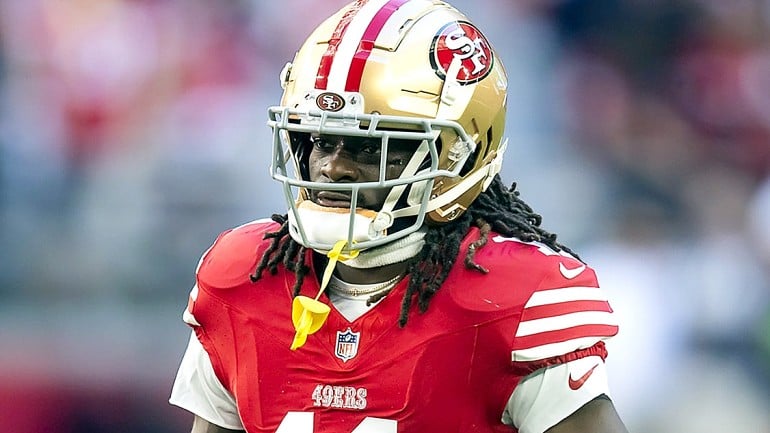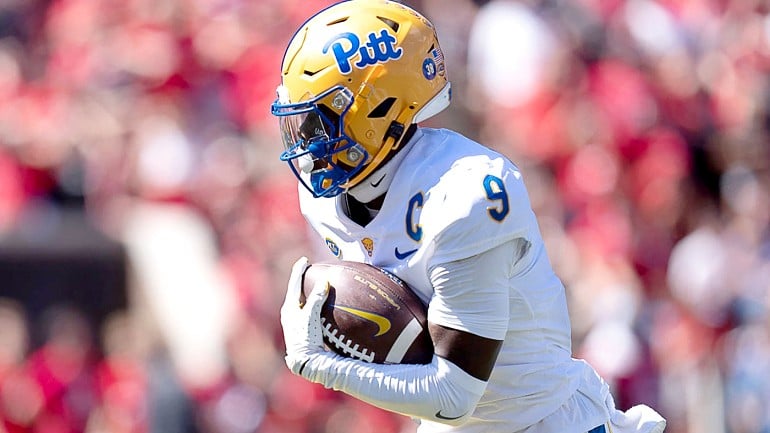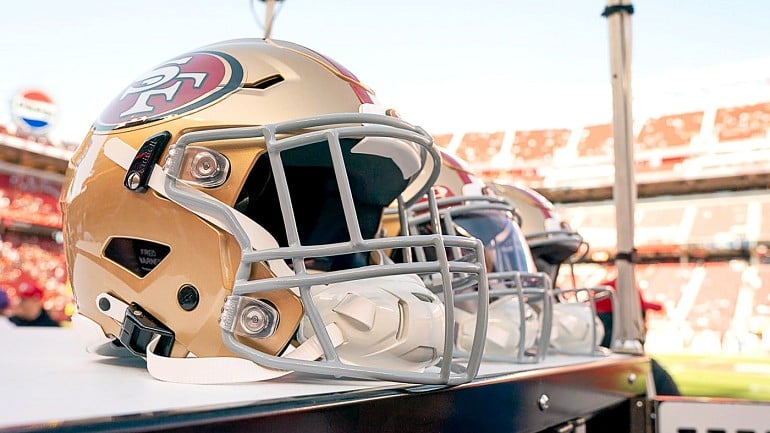Today we look at C.J. Beathard's performance from Week 4 against the Chargers.
C.J. Beathard was reinserted as the 49ers starter after an injury to quarterback Jimmy Garoppolo in Week Three against the Chiefs. The 49ers went through their week four preparations by meeting with, and working out, potential quarterbacks like Tom Savage and Matt Simms but elected to elevate Nick Mullens from the practice squad to the active roster to keep continuity of the offense and player development as the deciding factors, for now, for not signing a quarterback.
There was no reason to expect Beathard to elevate the play of the offense and give it the kind of quarterback play they've seen since Garoppolo took over. But Beathard also did enough to win them this game if not for the abysmal lack of talent that prevented them from scoring on key drives while he looked like a significantly better quarterback than last year.
So what does the film show?
THE GOOD
ANTICIPATION
One of C.J. Beathard's strengths is he has always been an anticipation thrower. He doesn't have the natural talent that Garoppolo has with his quick release so Beathard has needed to rely on the timing and rhythm of the offense and knowing when and where receivers are going to come open. This was on display this week against the Chargers.
Out of 21 personnel, (two running backs, one tight end, two receivers) the 49ers are running a basic deep curl concept off of play action with seven in protection. That many blockers keeps the quarterback clean and lets the routes develop.
This isn't a tight coverage throw but Beathard shows off good anticipation and the ability to throw to a spot where his receiver can catch it and turn up field. With Goodwin running the deep curl to the left, Beathard begins his throwing motion and releases the pass before Goodwin is even out of his break.
A pass thrown with anticipation like this prevents the defender from adequately making play on the ball. Chargers cornerback Trevor Williams can't recover in time to make a break on the ball and Goodwin catches and turns up field as Beathard take a hard hit and draws a roughing the passer penalty.
Later in the game out of a 3x1 trips bunch stack to the right, the 49ers are running the cross country dagger concept that has a post run by the inside slot receiver and a deep dig run by the outside receiver.
As Beathard drops back to throw, he begins his delivery as receiver Kendrick Bourne isn't fully of out his break and hasn't fully cleared his zone. Beathard hesitates very slightly, and this has the added benefit of freezing the hook zone defender.
As Bourne clears the defender, and tight end George Kittle clears out the middle of the field with his post route, Beathard throws to a spot and leads Bourne away from the defender in his hip pocket. If this pass is even slightly behind, Bourne would likely have to alter his catch point, further allowing the defender a chance to break up the pass.
Instead he catches it in stride but with the defender being so close anyways, Bourne gets tackled immediately. Throws like this happen when the quarterback trusts where his receiver is going to be in the progression. The fact that he was able to hit Bourne in stride while taking a shot to the knees in the pocket speak volumes about the rapport Beathard has with his receivers.
TIGHT WINDOW THROWS
Beathard's first touchdown pass of the day came on a "run-pass option" out of a pistol "full house" formation. The RPO to the front side of the play gives Beathard a choice between throwing to fullback Kyle Juszczyk out on the route out of the back field, handing the ball off to Breida, or throwing the backside slant to Bourne.
Beathard determines his read is going to be the backside of the play due to the numbers advantage to the left that the Chargers have. He knows that if he can get the Mike linebacker to bite on the run fake, then he can pull and quickly turn to fire a pass to Bourne on the slant.
The play action gets the middle defenders to bite hard on the run as they all take steps toward the run action of the quarterback/running back mesh point. Bourne gets his head outside the defensive back like he's going to run a fade, then immediately cuts back inside underneath the defender. Beathard pulls the ball as the defense steps toward the line of scrimmage.
The safety is also out of position and rolling downhill. He zips the pass right past the outstretched arms of the defense and into Bourne's chest for the touchdown.
POCKET AWARENESS
One of the more admirable traits in any quarterback is the ability to step into throws while taking punishing hits. The need to be able to get off an accurate pass while also being hit is a trait that not many quarterbacks possess.
Beathard does.
The play call has Kittle running a deep dig over the middle into the hole in the zone. At the snap, Chargers safety Derwin James blitzes through the right side B-gap untouched. Beathard knows he has to get this pass off and to a receiver 10-plus yards downfield.
As he hits the top of his drop, he rifles a pass over the offensive line as James hits him. The pass hits Kittle in stride and the 49ers move the sticks.
MANIPULATING COVERAGES
The ability to look off the coverage to create a throwing lane is also something Beathard excelled at last year and this past Sunday.
Against a cover three shell (or what looks like cover one in the hybrid Seattle defense in use by Gus Bradley), the 49ers are running an all verticals concept designed to put the safety into conflict. In this case, Kittle is running the deep "stick-nod" route that's designed to look like he's running an out route and quickly cuts back up the seam into the void left by the safety.
On Monday, head coach Kyle Shanahan detailed the play:
It was a zone play. So, all he tried to do was not show that he was running a seam so he ran a nod instead. When you run a seam, the safety carries you. When you run a 10-yard out, he doesn't. So, you try to make it look like that. That's why he was wide open. It was zone coverage. Then, it's up to C.J. to look the middle-third player off to get him to defend a go-route, which was on the left side. The O-Line gave him enough time to move his eyes to the right, to the left and to come back to the right. So, he moved the coverage well, which got Kittle open. He was wide open just by the coverage and the quarterback, then Kittle did a hell of a job making it into a touchdown.
As Kittle is running the stick-nod route, Beathard is looking off safety Jahleel Addae. As Addae gets his hips turned toward the go-route on the boundary side of the field, Beathard turns and throws to Kittle running up the seam.
Kittle catches it in the triangle of defenders and it's off to the races for the speedy tight end as he out-runs the safety and cornerback chasing him for an 82-yard touchdown score, the longest by a tight end in 49ers history.
THE BAD
One thing Beathard does have a tendency to do is hold on to the ball too long and not pull the trigger as the play develops. He is superb at throwing with anticipation, but there are occasional lapses in judgment where he should've thrown it at a certain point in the progression but instead waited a half second too long to pull the trigger.
With Kittle running the deep out route off play action, a huge void opens across the middle for Beathard to fit the pass into.
The above frame shows Beathard just after the point where he hits the top of his drop and hitches once to let the route come open. It is here where he should be halfway through his delivery if he would've anticipated Kittle coming open. The defense isn't going to recover in enough time if he throws now since it is playing the play action rules the way it's supposed to.
By the time Beathard releases, he had hitched a couple of more times up into the throw, allowing the defense to recover from the play action and get back to cover the pass.
The window closes rapidly, and Beathard's throw suggests as much as he now has to place the pass between Kittle and the boundary. The pass sails out of bounds.
INTERCEPTIONS
Despite some hiccups, Beathard played well enough to win the game if not for some glaring offensive issues that had nothing to do with the quarterback. The stat line doesn't tell the whole story either.
Beathard threw two interceptions, one that is not his fault, the other that mostly is his fault. The first came in the third quarter during Beathard's best drive of the game, helped along by 30 yards of Chargers roughing the passer penalties.
The first interception happened on a pass to tight end Garrett Celek that went right through his hands, off his shoulder pads, and into the waiting arms of Chargers cornerback Trevor Williams, who returned it 86 yards to the 49ers 12 yard line.
The Chargers would add three points and it was arguably the game changing play, considering the 49ers lost by two.
The second interception came when Chargers safety Derwin James (no. 33) came off the edge unblocked and strip sacked Beathard as he tried to get a pass out to Alfred Morris on the hot route out of the backfield.
Prior to this blitz, the Chargers had blitzed something similar earlier in the game called a "single dog" blitz where the safety blitzes while the
coverage rolls to the side of the blitz. The corner plays a sky zone, providing help over the man-to-man coverage to the defense's right side near the boundary.
The 49ers are in a gun far doubles with a twins stack to the right formation and running two go-routes to the boundary on the left and a seam route and quick out from the stack bunch to the right.
The pass rushers to the blitzing side take an inside rush and occupy the gaps along the offensive line. This frees up James to blitz off the edge.
Beathard picks up the blitz and rightly makes the hot read to Morris and tries to get a pass around James as he blitzes. However, with James running at full speed toward Beathard, Beathard throws it right to James who swats it away.
In a similar scenario on the 49ers' final play of the game, the Chargers again send the same blitz. But there appeared to be miscommunication as both safeties James and Addae come on a double safety blitz.
The rushing assignments are almost identical to the play above except this time, the Chargers have the extra blitz man.
Beathard notices Addae closer to the line of scrimmage and focuses on his movement post-snap. The Chargers blitzed with six against the 49ers five pass blockers Morris runs right by James (the unblocked defender) and never chips him to slow him down.
Beathard recognized the blitz too late as James runs unabated to the quarterback and hits him. Beathard still tries to throw it but it ends up in the hands of Chargers defensive end Isaac Rochell.
Overall, Beathard did not play badly. He wasn't great, but certainly wasn't bad either and he gave the 49ers chances to win the game. He isn't the household national name that Garoppolo is either, but there's reason to believe that he can win some games and make plays to keep them competitive in games. So far after his first start this season the signs are encouraging.
All pics and images courtesy of the NFL.
All statistics courtesy of Pro Football Reference.
